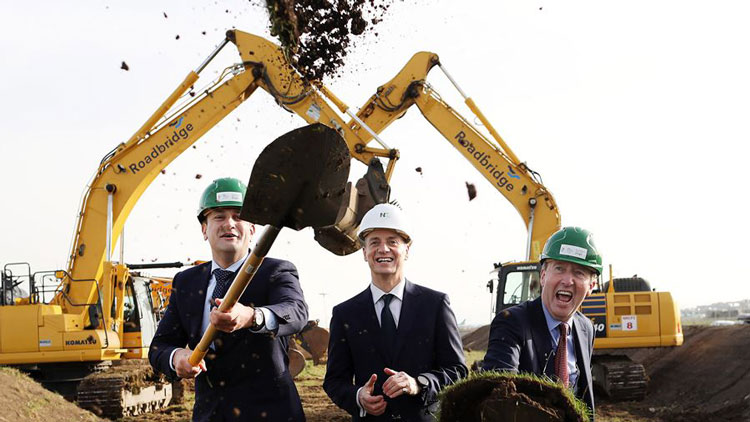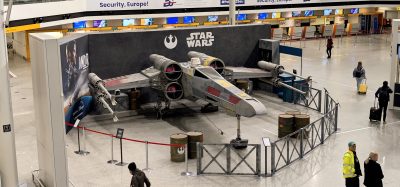Work begins on new North Runway project at Dublin Airport
- Like
- Digg
- Del
- Tumblr
- VKontakte
- Buffer
- Love This
- Odnoklassniki
- Meneame
- Blogger
- Amazon
- Yahoo Mail
- Gmail
- AOL
- Newsvine
- HackerNews
- Evernote
- MySpace
- Mail.ru
- Viadeo
- Line
- Comments
- Yummly
- SMS
- Viber
- Telegram
- Subscribe
- Skype
- Facebook Messenger
- Kakao
- LiveJournal
- Yammer
- Edgar
- Fintel
- Mix
- Instapaper
- Copy Link
Posted: 19 February 2019 | International Airport Review | No comments yet
The new runway is part of the Government’s €116 billion Project Ireland 2040 plan to modernise the infrastructure, and will create more than 31,000 Irish jobs.


Credit: Dublin Airport - From left to right: Leo Varadkar, Shane Ross and Dalton Phillips
The Prime Minister of Ireland, Leo Varadkar TD, and the Minister for Transport Tourism and Sport, Shane Ross TD, performed the official sod-turning for Dublin Airport’s new North Runway project.
The new runway is needed to allow for expansion to underpin Ireland’s long-term economic growth. Dublin Airport’s existing main runway is effectively full at peak times every day following a 45 per cent increase in passenger numbers since 2014.
The delivery of North Runway is a key recommendation of the Government’s National Aviation Policy, as it will significantly expand connectivity at Dublin Airport and also enable it to continue to grow as a gateway between Europe and North America.
The new 3.1km runway will be located almost 1.7km north of Dublin Airport’s current main runway. Construction will take about two years and a nine-month period of commissioning will then take place. North Runway will support the creation of 31,200 new Irish jobs and €2.2 billion in additional economic activity by 2043.
Varadkar said: “Dublin Airport is our main gateway to the world and is crucial for Irish tourism, business and trade. This new runway is part of the Government’s €116 billion Project Ireland 2040 plan to modernise our infrastructure, remove bottlenecks and enable future growth. Connectivity is one of the principles behind Project Ireland, linking Ireland to the world and all parts of Ireland to each other.
“More than 31 million passengers passed through Dublin Airport last year, with new routes opening in 2019 to Shenzhen in China, four locations in North America, and routes to the Ukraine. The North Runway will allow further expansion, with connections from Dublin expected to rise by a third within ten years of opening. It’s been promised for decades. Under this Government, it’s being delivered. So, I’m honoured to be here, along with my colleague Minister Ross, to turn the sod and formally start work on it.”
Ross commented that the new runway would have a significant impact for tourism by making it easier to visit Ireland from overseas. He said: “The extra capacity that will be delivered by the North Runway is excellent news for Irish tourism. The North Runway, which is a key investment within Project Ireland 2040, is strategically important for the entire country and we need to deliver it as quickly as possible.
“The North Runway will bring new airlines to Ireland and allow airlines that operate here already to expand their networks. This will open up new long-haul and short-haul markets and provide a greater choice of routes and airlines.”
daa Chief Executive, Dalton Philips, said it was a historic day for Ireland and for Dublin Airport: “Our main runway opened 30 years ago this year and it has been a linchpin of the Irish economy during the past three decades. Annual traffic has grown from five million passengers in 1989, when Runway 10/28 opened, to a record 31.5 million passengers last year. The North Runway will enable continued expansion and connectivity growth at Dublin Airport in the decades ahead.”
The €320 million North Runway project will be funded through a combination of daa’s own revenues and borrowings, at no cost to the State. In fact, daa is a significant contributor to the Irish Exchequer, having paid €85 million in dividends and €347 million in taxes since 2014.
Separately, daa is also planning a new five-year investment programme for Dublin Airport. It includes a €900 million investment in new boarding gate areas, aircraft parking stands and other improvements alongside about €200 million worth of airfield works and a €120 million annual spend on repair and maintenance and revenue generating projects.
The North Runway is being built by a joint venture comprising Irish construction company Roadbridge and the Spanish infrastructure group FCC Construcción (FCC). Roadbridge FCC won the main construction contract last October, following an international tender process.
More than 300 construction workers will be employed onsite and hundreds of jobs will also be created by related activities offsite. Roadbridge FCC will be working closely with the daa and Fingal-based development company Empower to fill as many positions as possible from within the local community.
The contract includes building 306,000m2 of new runway and taxiways, six kilometres of new internal airport roads, and two new electricity substations. New drainage and pollution controls will be installed, as well as about eight kilometres of electrical cable, over one kilometres of CCTV cable and more than 2,100 new runway and taxiway lights.
While construction of the North Runway progresses, the daa will continue to seek the amendment of two planning conditions relating to flights between 23:00 and 07:00 that will apply once the new runway is built.
Philips said: “It has never been Dublin Airport’s intention to have lots more flights in the middle of the night, but the new conditions would have a very significant impact on the business, as 06:00 -07:00 is the airport’s busiest time of the day. We are acutely aware of the concerns of local residents in relation to this development and there is a balance to be struck between those concerns and Ireland’s national economic needs.”
Legislation to establish a new independent aircraft noise regulator at Dublin Airport is currently going through the Oireachtas. The views of the daa, local communities and other stakeholders will be taken into consideration, and the regulator will make its decision based on an EU framework for assessing noise at airports.
The daa works closely with airlines, the Irish Aviation Authority and ground handling firms to minimise aircraft noise at Dublin Airport and is also introducing a series of mitigation measures in relation to noise. The daa is insulating about 200 homes near the airport to the highest standards and has also set up a voluntary scheme to buy up to 38 properties that are most affected by the North Runway development.
Related topics
Airport construction and design, Airport development, Airside operations, Capacity, Economy, Passenger experience and seamless travel, Regulation and Legislation, Runways and pavements
Related airports
Related organisations
daa, FCC Construcción, Ministry for Transport Tourism and Sport, Roadbridge, Roadbridge FCC


















